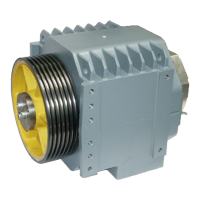OPERATING MANUAL 3. PRODUCT DESCRIPTION
ThyssenKrupp Aufzugswerke GmbH 14 Issue 06.2004
3.2 Functional description
Machine: DAF270 consists of a frequency-controlled permanent-magnet
synchronous motor.
DAF270 has two different power ranges, which are differentiated by the letter
behind the type designation:
DAF270 M (medium) for the standard and DAF270 L (large) for the higher
power range. The external housing dimensions differ in size. See chapter 3.6
Dimensions.
The machine has a monobloc housing with integrated bearing bracket on one
side.
The drive shaft with rolling bearings is made of tempering steel.
The front self-aligning bearing and the rear rolling bearing of the bearing
bracket are sealed and life-time lubricated.
DAF270 is designed for 1 : 1 and 2 : 1 suspension with single wrap
(max.180°) and downward rope departure.
(The motor terminal box is accessible from below.) In all other cases, turn the
drives and adjust the mounting position to the respective access.
Motor: dependent on motor type and controller the braking energy can be:
a) supplied to resistors;
b) regenerated sinusoidally to the mains. (Only for motors ≥ 350V)
The machine is designed for thermal class F but used according to thermal
class B.
DAF270 has a self-ventilated motor (without auxiliary forced ventilation)
Operating temperature (max. 130°C ± 5°C) is monitored by a posistor.
Evaluation by means of a frequency inverter. In case of overheating the drive
is de-energized through the inverter.
Traction sheave: the single-block (rim and nub) overhung traction sheave is
attached onto the conical end of the motor shaft and secured against falling
down by screw-connected disc on the front side. The micro-encapsulated
screws are protected against unintensional working loose and provided with
detent edged washers placed under.
The groove flanks are hardened as standard (≥ 50 HRc).
For further data see chapter 3.3 Technical Data.
The gearless machine does not have a self-locking device.
Brake: an electromagnetically operated, dual-circuit brake is attached to the
motor housing. It consists of two independently operating brake shoes
(tandem), which act onto the motor shaft.
The spring-applied armature disk of the respective magnetic brake is pressed
against the brake lining of the rotor. The rotor is pushed and the second rotor
lining acts on the rigid bearing surface of the brake or the bearing bracket.

